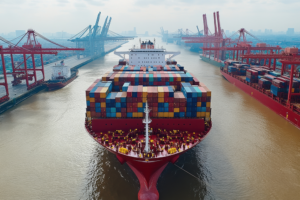
I was talking with a CEO last month who described his company’s supply chain technology as “watching a movie of our business instead of actually running it.”
That conversation crystallized something I’ve been thinking about for years: the fundamental difference between observing and commanding. Most organizations have invested millions in what the industry calls “control towers” – sophisticated dashboards that provide beautiful visibility into their supply chains. But here’s the uncomfortable truth: visibility without action is just expensive entertainment.
Let me share why the military comparison your technology vendor used to sell you that control tower might have been backwards from the start.
The Military Metaphor Everyone Gets Wrong
When supply chain vendors talk about “control towers,” they’re borrowing from air traffic control – a system designed to coordinate independent actors, not command integrated operations. Air traffic controllers don’t own the planes; they manage the intersection points.
Command centers operate on entirely different principles. They’re built for unified command, rapid decision-making, and coordinated response. Picture this scenario: when a crisis hits, do you want your team gathering around monitors discussing what they’re seeing, or do you want them executing coordinated responses based on predetermined protocols?
The distinction matters more than most executives realize.
KEY INSIGHT: Control towers show you what happened. Command centers help you decide what happens next.
Why Visibility Isn’t Victory
Here’s what I’ve learned from working with organizations at every stage of supply chain maturity: the companies winning in today’s market aren’t the ones with the best dashboards – they’re the ones with the fastest, most coordinated responses.
Traditional control towers excel at three things:
- Aggregating data from multiple systems into unified views
- Creating alerts when predefined thresholds are breached
- Generating reports that explain what went wrong after it’s too late
But think about what’s missing from that list: decision-making capability.
When a supplier signals potential delays, when demand patterns shift unexpectedly, when transportation costs spike – your organization needs to move beyond “we can see the problem” to “here’s our coordinated response.” The gap between awareness and action is where competitive advantage gets lost or won.
The Active Management Revolution
Command centers represent a fundamental shift from passive monitoring to active management. Instead of waiting for humans to interpret data and coordinate responses, they embed decision logic directly into operational workflows.
Imagine if your supply chain could automatically:
- Reroute shipments based on real-time cost and timing analysis
- Adjust procurement priorities when demand signals change
- Coordinate cross-functional responses to supply disruptions
- Optimize resource allocation across multiple constraints simultaneously
This isn’t about replacing human judgment – it’s about amplifying human decision-making with coordinated execution capabilities.
REALITY CHECK: How many hours per week does your team spend in meetings discussing supply chain issues that could be resolved through automated protocols?
The Competitive Advantage Gap
While your competitors are still holding “supply chain review meetings” to discuss what their dashboards are showing them, organizations with true command center capabilities are already three steps ahead in their response cycles.
The mathematical reality is stark: every day you spend analyzing problems instead of solving them is a day your competition gains ground. Markets reward speed of response more than depth of analysis.
Consider the last major disruption your organization faced. How much time elapsed between problem identification and coordinated response execution? Now imagine cutting that time by 75% through automated decision protocols and coordinated response capabilities.
Beyond Technology: The Organizational Shift
Here’s what most executives miss when they think about upgrading their supply chain technology: command centers require different organizational muscles than control towers.
Control tower organizations develop strong analytical capabilities. They become excellent at understanding problems in detail. But command center organizations develop something more valuable: response coordination capabilities.
This means shifting from:
- Reactive analysis → Proactive scenario planning
- Siloed responses → Coordinated execution
- Meeting-driven decisions → Protocol-driven responses
- Historical reporting → Predictive action
STRATEGIC QUESTION: Is your supply chain technology helping you win, or just helping you understand why you’re losing?
The Integration Challenge Nobody Talks About
One of the biggest revelations from my conversations with supply chain leaders is how much effort gets wasted on integration theater. Organizations spend enormous resources connecting systems to create “single panes of glass” without asking the fundamental question: what decisions will this enable that we couldn’t make before?
Command centers solve integration differently. Instead of connecting systems to create better reports, they connect systems to enable coordinated actions. The goal isn’t comprehensive visibility – it’s rapid, informed response.
This shift changes everything about how you evaluate supply chain technology investments. Instead of asking “what can we see?” the question becomes “what can we command?”
The Economics of Speed
Let’s talk about the financial reality that’s driving this evolution. The cost of supply chain decisions isn’t just about making the right choice – it’s about making good-enough choices faster than your competition.
Every industry has examples of companies that won market share not through superior analysis, but through superior response speed. They didn’t have perfect information; they had coordinated action capabilities that let them adapt faster than competitors who were still analyzing.
Command centers represent an economic bet on speed over perfection, coordination over analysis, and action over observation.
What True Command Looks Like
When I describe command center capabilities to executives, I often get the response: “That sounds like AI making all our decisions.” But that misses the point entirely.
Command centers don’t replace human judgment – they operationalize it at scale. They take the decision frameworks your best people use and embed them into automated response protocols. They turn your organizational wisdom into coordinated action capabilities.
The result isn’t less human involvement – it’s human expertise applied more effectively across your entire operation.
THE TRANSFORMATION QUESTION: What would happen to your competitive position if your supply chain could respond to changes in hours instead of weeks?
Making the Mental Shift
The hardest part of this transition isn’t technological – it’s mental. Organizations get comfortable with the illusion of control that comes from comprehensive visibility. Those beautiful dashboards create a sense of mastery that feels productive even when it’s not driving results.
Command center thinking requires accepting that perfect information is less valuable than coordinated response. It means optimizing for action over analysis, speed over certainty, and coordination over individual expertise.
For many organizations, this represents a fundamental shift in how they think about supply chain management.
The Path Forward
If you’re reading this and recognizing your organization in the “control tower” description, you’re not alone. Most companies are still operating with technology architectures designed for a slower, more predictable business environment.
The question isn’t whether to evolve – it’s how quickly you can build command center capabilities before your competition does.
Start by auditing your current supply chain decision cycles. Identify the gaps between problem awareness and coordinated response. Look for patterns where your team spends time discussing obvious solutions instead of implementing them.
Those gaps represent your transformation opportunities.
EXECUTIVE TAKEAWAY: The companies that will dominate the next decade aren’t the ones with the best supply chain visibility – they’re the ones with the fastest, most coordinated supply chain responses.
The Competitive Reality
Here’s the truth that keeps me up at night: while some organizations are debating whether to upgrade their control towers, others are already deploying command centers that make traditional supply chain technology look like abacuses in a computer age.
The window for competitive advantage through supply chain command capabilities is open now, but it won’t stay open forever. First movers in any technology category establish advantages that become harder to overcome as the technology matures.
Your competitors aren’t standing still. The question is whether you’ll lead this transformation or spend the next five years catching up to it.
—
What’s been your experience with supply chain visibility versus action capabilities? Have you found gaps between what your systems show you and what your organization can actually execute? I’d love to hear about the decision-making challenges you’re seeing in today’s supply chain environment.
The difference between watching your supply chain and commanding it might be the difference between surviving and thriving in the decade ahead.
and boost your Supply Chain Management









